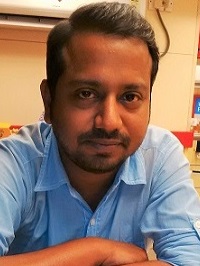Visiting Researchers
 |
Institute |
Department of Geology, University of Calcutta |
Title |
Senior Research Fellow | |
Country |
India | |
Period of Stay |
2017/2/1 - 2017/7/31 | |
Research Theme |
Stress accumulation and relaxation in ‘soft’ outer wedge in subduction zones: an experimental approach | |
Host Researcher |
Masao NAKATANI |
Basically I am an experimental structural geologist. Despite my focus on experimental work in my doctoral study, I was an active part of several exciting and exhaustive fieldworks in different deformed terranes of the Indian subcontinent with special emphasis on the various eastern Himalayan transects. Before joining ERI as a Visiting Researcher, I was engaged in the reconstruction (including designing and successful implementation of all the instrumentation required for physical modelling) of the Experimental Tectonics laboratory (ETL) of the University of Calcutta, India initiated by my doctoral supervisor. My doctoral research enabled me to be acquainted with various physical modelling techniques extensively thus making me capable of handling different analogue models and varied types of machinery required for successful experimental runs and consequently my expertise includes an understanding to address the kinematics of deformation in orogenic belts by using laboratory scale physical experiments in a sandbox apparatus. My principal publications in peer reviewed journals dealt with the deformation processes (faulting processes and thrust mechanics) in convergent belts using physical experiments (substantiated at times in the form of numerical models).
Here at ERI, I shall work in collaboration with Prof. Nakatani Masao on stress accumulation and relaxation in the soft outer wedges in a subduction setting. The problem shall be dealt with in a multi-dimensional manner, one of the key elements of the approach being testing wedge softness in a triaxial apparatus. This approach shall conclusively be followed by testing the effects of different material properties (physical properties found in slurry suspension as well as weight ratios of sand and mud generating the degree of softness) on the strain accumulation. Subsequently a first of its kind regime diagram demonstrating the relation between sand-mud ratio in the outer wedge and deformation temperature shall be constructed. I would like to conclude on the note that this regime diagram will be the most important and convincing dissemination of the results of my work at ERI which will conclusively enable a proper understanding on the phenomenon of long term strain accumulation as well as short term accumulation of strain leading to stick-slip deformation in nature. Lastly I am hopeful for the continuation of this project and further collaborations after this visiting postdoctoral fellowship at ERI.
